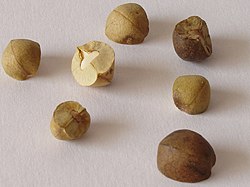This article needs additional citations for verification .(July 2010) |


Mexican jumping beans (Spanish : frijoles saltarines) are seed pods that have been inhabited by the larva of a small moth ( Cydia saltitans ) and are native to Mexico. The pod is usually tan to brown. They are from the shrub Sebastiania pavoniana , often also referred to as "jumping bean." However, they are not related to actual beans (legume plants), but rather to spurges. The beans are considered non-toxic but are not generally eaten. [1] In the spring, when the shrub is flowering, moths lay their eggs on the shrub's hanging seedpods. When the eggs hatch, tiny larvae bore into the immature green pods and begin to devour the seeds. The pods ripen, fall to the ground and separate into three smaller segments, and those segments are called Mexican jumping beans. As the tiny larvae inside curl up and uncurl, they hit the capsule's wall, and the bean appears to jump. They move more as temperatures rise. The larva eats away the inside of the bean (until it becomes hollow) and attaches itself to the inside of the bean with silk-like thread.
Contents

Physicists at Seattle University theorize, using Brownian motion as a model, that the larva's random walk helps to find shade to survive on hot days. Although it does not optimize for finding shade quickly, the strategy minimizes the chances of never finding shade when shade is sparse. [2]
The larva may live for months inside the bean with varying periods of dormancy. If the larva has adequate conditions of moisture and temperature, it will live long enough to go into a pupal stage. In the spring, the moth forces itself out of the bean through a round "trap door," leaving behind the pupal casing. After its metamorphosis, the small, silver and gray-colored moth lives for no more than a few days. [3]